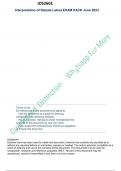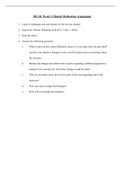Exam (elaborations)
IOS2601 MAY/JUNE 2023 Exam Answers Included, Multiple Choice Questions with Answers
Interpretation of Statute Latest EXAM PACK June 2023 IOS2601 MAY/JUNE 2023 Exam Answers Included, Multiple Choice Questions with Answers. Multiple Choice Questions Question 1 Promulgation refers to... (1) the different stages, readings and processes through which legislation has to pa...
[Show more]




